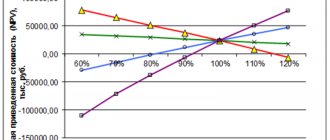Every project your team works on is very different from the others. Other team members. Other deadlines. Other requirements. Other goals.
But these seemingly different projects have much more in common than might seem at first glance. Each of them has a beginning, middle and end. Each of these stages involves repeating processes.
How can we use this sequence and highlight each stage, regardless of the specifics of the project? Let's look at a typical project life cycle and learn how your team can make each phase as efficient as possible.
What is the project life cycle?
A project is not a routine production activity. It is distinguished by limited deadlines. The concept of life cycle is especially common in economics and management due to the specific nature of projects. The life cycle involves a set of successive phases. Their features depend on the needs of the company and the characteristics of management processes. The cycle includes various stages that are implemented during the execution of the project.
What are the requirements for design and estimate documentation ?
The life cycle is divided into phases. These are large periods of time that are distinguished by a number of characteristics. The phases, in turn, are divided into stages. The exact number of phases and stages cannot be determined. This depends on the specifics of the specific project. At the same time, the components of the cycle differ in common characteristics. Project management is carried out based on phases and stages.
Start and end
IMPORTANT! Planning recommendations from ConsultantPlus are available here
To determine the life cycle, you need to establish its beginning and end. The following actions can be considered the beginning of execution:
- Start of financing activities.
- Formation of an idea.
- Date of initiation of execution of planned work.
Let's look at the signs of project completion:
- Putting the object obtained during the project into operation.
- Fulfillment of previously formed goals.
- Completion of the payback period.
- Completion of financing.
- Dissolution of the team of employees who worked on the project.
- Liquidation.
The life cycle is the length of time from the beginning to the end of work.
Definition of concepts
Those of us who have some experience in project management or at least a little theoretical background are familiar with a number of phenomena that a manager uses to imagine the life cycle of an investment problem and plan its solution. The list of these categories is simple at first glance and includes:
- life cycle phase;
- milestone;
- stage;
- stage;
- management process.
The proposed concepts are often used as synonyms in practice. And if you look in the sources, there is a chance to find that dictionaries also “sin” with circular definitions of these philosophical and applied categories. You can also notice in the scientific literature that “a phase is a stage”, “a stage is a stage” and even a milestone is defined as a certain stage of the path. What should we do, since we need to operate with an accurate perception of phenomena?
I propose to follow the procedure that we already did once with the categories of project tasks, goals and problems. Let us strengthen our common sense and look at the concepts presented above from the perspective of ordinary empirical experience. Below is a table in the columns of which the categories under study are indicated, and in the tabular part we will place definitions, images, examples that correspond to them. Let's start with the concept of "phase". What is the essence of this concept? How can it be characterized, what are its distinctive qualities?
The composition of the distinctive qualities of basic design concepts
The article on the life cycle of a project task is devoted to the phases of project implementation. Empirically, I most think of a phase as an ongoing and expressed state of project execution, such as the development phase or the completion phase. The design task has several of these provisions, and they are always repeated, whether we want it or not. There may be several principles for dividing a project into phases, but the approach to their formulation is the same - from the perspective of a continuing state.
An option for dividing the project into phases from the position of transferring responsibility from the PM
Option for dividing a project into phases from the perspective of the project life cycle
Above, as an illustration, is an example of two project phase breakdown schemes. From the point of view of the life cycle, the project phases are crowned by milestones - important, significant events of its implementation. On the timeline, they represent event points. Project phases are divided into stages - ascending periods of development, separating the qualitative states of the phase. For example, the stage of making a decision to start a project or the stage of forming a project team. A more dynamic category than phases and stages are management processes that have the following features:
- represent a sequence of work;
- related to management, based on a regulatory framework;
- may relate to the project as a whole or to a specific phase of it.
The stages are parts of management processes, which include essentially homogeneous compositions of work. Thus, a stage is a dynamic category that can be repeated at each phase of the project . For example, the analysis stage. In small projects, milestones, phases, and phases actually become synonymous. In large events, the stages are most pronounced in the processes of initiation, completion, planning and organization of execution.
Life cycle phases
The phases depend on the specifics of the project. Let's consider the phases of the investment project:
- Preparation. In this phase, research is carried out and the best project option is selected. Negotiations are underway with counterparties.
- Investment. In this phase, shares or other financial instruments are sold. The company receives funds to implement the idea.
- The project begins to operate according to plan.
- Post-investment research, which involves analyzing the effectiveness of activities.
In most projects, exactly 4 phases are implemented. However, there can be both two-phase and three-phase projects.
Operational stage: the importance of preliminary calculations
Most projects turn out to be insolvent and unprofitable due to poor quality work on:
- researching market potential (too optimistic estimates of the purchasing power of society in relation to your particular product);
- assessing the availability of production factors precisely at the prices specified in the memorandum (in practice, it either turns out to be more expensive or cannot be obtained at all at any price);
- research into the marketing component of the market, which is devoted to identifying the best sales price.
Cheerful top managers, who strutted importantly at the stage when they needed to receive money, usually walk with their heads hanging when they need to answer for their words of promise. However, all these difficulties could well have been avoided if we had not immediately been greedy and spent time, money and attention on relevant research in order to do them not “for show”, but conscientiously, for our own confidence.
After all, preparing a project for implementation implies, first of all, an in-depth study of issues related to:
- profitability of the production process;
- sales market capacity;
- danger of an administrative and political nature (especially in Russian realities).
Life cycle stages
It must be kept in mind that a stage can be divided into substages. This breakdown is needed for ease of execution. The cycle is divided into 4 stages:
- Conceptual stage. At this stage the project is just being initiated. The formed idea is carefully studied. A forecast is made regarding profitability. The goals and objectives of the project are set, and the team that will be assigned the work is determined. The manager also needs to identify sources of funding. This is an extremely important stage. If a full analysis is not carried out at this stage, the performance results may be unsatisfactory.
- Planning. Planning is the formation of a project plan. The plan is a pre-created order of activities, a list of upcoming tasks, and the sequence of their solution. At this stage, a strategy, project policy, and a set of actions that are needed to achieve the goals are formed. Planning may also include an analysis of the profitability of the project and identification of possible risks. In the future, the activities of workers will be verified specifically against the drafted project. Planning concerns all stages of the life cycle. The formed solutions must ensure the achievement of the goal, the implementation of the project in a short time with minimal costs. Without planning, coordinated activities of all project participants are impossible. It is on the basis of the plan that control measures, accounting, and operational management are carried out. The plan must be approved by the manager.
- Project implementation. After the plan is approved by the manager, its provisions begin to be implemented. The manager must monitor the activities of employees. How are control activities carried out? The manager collects information about the progress of work, after which the information received is checked against the plan. Deviations from the plan must be excluded. However, it must be borne in mind that they cannot be completely eliminated. There is an acceptable level of deviations that does not significantly affect the results of operations. If a critical level of deviations is recorded, additional resources may be allocated to eliminate them.
- End of the project. The project will be completed when the previously established deadlines expire. However, to determine the completion of work, you cannot rely only on deadlines. Achievement of set goals should also be taken into account. In some cases, the project ends prematurely. This may be due to liquidation or termination of financing. In any case, completing a project involves taking certain actions. The exact list of these actions depends on the specifics of the project. This could be an inventory, transfer of equipment to a warehouse, reconciliation of the results of contract projects with the provisions of the contract. An extremely important part of the project completion activities is the preparation of the final report.
This is the most approximate list of life cycle stages. The exact list is determined by the specifics of the project.
Development of a creative project
A creative project is the same research as an investment one. However, there is one difference, which is that the end result must be a finished product. A creative person must be able to translate his thoughts and ideas into reality so that his abilities do not remain useless. For this you need to master the skill of design. The stages of a creative project are:
- Selecting a design theme, setting goals and corresponding tasks.
- Setting all sorts of restrictions.
- Determining the required resources.
- Gathering the necessary information.
- Drawing up a design plan.
- Manufacture of the product taking into account all of the above factors.
- Evaluation of the finished product.
- Analysis of results.
- Registration of the study in paper form.
- Project protection.
Each creative person sees these stages of the project in his own way. Therefore, it is not necessary to strictly follow the instructions. It is enough just to adopt these requirements in general terms.
Features of the organization of the control system
Control measures play a key role in life cycle. An effective control system is based on these principles:
- Formation of a clear plan. Control involves reconciling planned and actual indicators. This is why it is so important to make a plan. This is the basis for the implementation of control measures. If necessary, the provisions of the plan can be changed. However, correction should not be carried out too frequently, as this will reduce the effectiveness of control.
- Formation of a clear reporting system. The report contains information about the status of the project. Actual indicators are compared with planned ones. The results must be recorded in reports. The comparison uses the same criteria. It is important to stipulate the deadlines for submitting a particular report. The information contained in the documents is submitted for collegial discussion.
- Creation of a full-fledged system for analyzing real indicators. If, as a result of reconciliation of actual and planned indicators, deviations from the plan are discovered, their seriousness is considered. There are acceptable deviations that do not significantly affect the final results of the activity. However, it is important to pay close attention to serious deviations. They can negatively affect the outcome of the project. Typically, the progress of a project is analyzed in terms of two key aspects - time and cost. Some tasks take too long to complete. Others require too much money to implement.
- Creation of a trend analysis system. The manager must predict emerging trends. That is, the specialist identifies risks and problems that may appear in the future. For example, a designer left the company. The manager understands that the design part of the work will be idle. That is, the deadlines for completing this task may be missed. The manager also forecasts an increase in costs.
- Developing an effective response system. The last stage of control activities is actions aimed at eliminating detected deviations. Not all deviations can be removed. If their elimination is not possible, the project plan is edited.
It is recommended to monitor the activities of employees at every stage. Timely detection of minor errors allows you to quickly eliminate them and prevent the occurrence of major shortcomings.
What does it include
The operational stage of development of an investment project includes the following.
The closest possible implementation of the actions and decisions stated in the business plan
It is difficult to foresee “onshore” all the difficulties a business may face during its development. However, references to endless force majeure are a banal consequence of poor project development. Why take on obligations in an area where the situation changes like the weather in May? This is a typical mistake by a project developer.
Focus on profit
Whatever altruistic goals a project may claim, it is only viable when it generates profit. Non-profit organizations are not those that do not make a profit, but those that are limited in their freedom to use this profit. Ensuring maximum efficiency in the use of labor, creativity, the prospects of new developments, increasing the quality of products - all of these are purely secondary goals compared to financial profit indicators. And once again: it is not revenue that is important (although its growth is an extremely good sign), but rather profit, which allows the formation of reserves.
Loan repayment policy
No matter how much you want to devote all your efforts and resources exclusively to the development and growth of the business (especially if the success of the project is noticeable), it is imperative to provide for the withdrawal of liquidity from circulation to pay off the loan. This needs to be done simply because bankers (lenders) are impatient guys and they don’t really like it when people forget about them. Borrowed funds must be repaid:
- not larger amounts than determined by the loan repayment schedule;
- no less;
- without delaying the specified deadlines.
The operational stage is much more complex and interesting, so we can make do with general recommendations. It seems reasonable to look at this process in more detail.
Example of life cycle phases
As mentioned earlier, the structure of the life cycle depends on the specific project. Let's look at an example of phases for a construction company:
- Pre-investment. Preliminary research is carried out, including an analysis of the development of the region, the creation of an investment idea, its coordination with managers, and the preparation of offers. The viability of the project is assessed and examinations are carried out. A preliminary plan is being formed. The second subphase is the creation of design estimates and preparation for work. At this stage, a plan for design and survey work is formed, the project is agreed upon, and working documentation is approved. At the same phase, a plot of land for construction is acquired. It is required to obtain a permit for construction work.
- Investment or construction. The first subphase is the preparation of contracts and tenders. The second subphase is the construction and installation work itself. At this stage, an operational construction plan and equipment operation schedules are formed. At this phase, monitoring the activities of employees is mandatory. Contractors' work is paid. The third subphase is the end of the construction phase. Includes commissioning, delivery and acceptance, analysis of work results.
- Operational. Includes direct operation of the facility and repair work.
- Completion. Involves decommissioning and dismantling of the facility.
This is a standard 4-phase project with a beginning and an end.
Risks of managing an investment project
Risk analysis makes it possible to understand when and to what extent you should expect a return on invested capital. Project risk refers to the likelihood of adverse financial consequences leading to loss of expected income. Its level is influenced by the external and internal environment.
Risks accompany all stages of implementation:
- Pre-investment ones are related to the choice of idea, the validity of assessing the main indicators of economic efficiency.
- Investment - with ineffective control, untimely completion of work.
- The operational group of risks includes supply problems, late achievement of design capacity, unqualified employees, and the level of competition.
- When a company is liquidated, there may be delays in the sale of assets.
It is important to conduct a critical analysis to reach the expected level of profitability.
Life cycle structure
The project cycle structure includes various processes:
- Organizational. Includes project management, infrastructure formation, life cycle analysis, and training events.
- Basic. They include the purchase of resources and their supply, development, commissioning and operation, and accompanying activities.
- Auxiliary. These are document flow, configuration management, work on improving quality, verification, certification, evaluation and work with problem areas.
All these processes are interconnected. Competence of organizational processes ensures the success of other processes.
Project stages: general characteristics
Although there are many types of projects, each of them is implemented according to a specific scheme. In general, the design process goes like this:
- The idea is analyzed and a project plan is developed.
- A project manager is selected.
- The design goals are clearly stated, taking into account all possible restrictions.
- Design participants are identified.
- The start date of work and the planned scope of the project are determined.
- Possible risks and consequences are identified.
- We are working towards our goal.
- Problems that arose during the work are eliminated.
- The final result of the project is analyzed.
- The result is presented to management.
- The final result and the work of the participants are assessed.
Depending on the type of design, this plan can be adjusted for specific purposes. New stages of work on the project can be introduced or existing ones can be eliminated if they are not needed.
Main processes and their characteristics
Let's consider the basic processes included in the life cycle structure:
- Acquisition. The customer identifies needs that may arise during the course of the project and makes purchases accordingly.
- Supply. An agreement is drawn up, the project’s operating system is formed, as well as technical requirements. Delivery is made in accordance with the provisions specified in the contract.
- Development. Work is underway on the project object.
- Exploitation. Includes the formation of operational standards and testing.
BY THE WAY! Processes can also be auxiliary. These include documentation, quality control, certification.
Evaluating the effectiveness of investment projects
Assessing the indicators of an investment project allows us to judge its profitability and viability. Investors tend to soberly evaluate incoming statements and figures. They think in terms of profit and benefit, so during negotiations it is better to present specific indicators of economic efficiency.
Calculation of the economic efficiency of the project
The economic efficiency of the investment project is reflected by the following indicators:
- Net income is the profit of an enterprise minus taxes.
- Net present value is the expected inflow of cash minus the initial investment and recurring costs.
- Profitability index. Helps to select the best of projects with similar net present value values with limited financial resources.
- Internal rate – a rate that protects against losses on deposits; equality of income from investment to costs.
- Payback period is the period of time after which income becomes equal to the amount of money invested.
Life cycle models
The life cycle model helps to understand the specifics of how work gets done. In particular, a model is a detailed description of the sequence of necessary actions. This is a set of actions necessary to achieve a goal. Models depend on the specifics of the project. General patterns are difficult to identify. Let's consider cycle models that are relevant in software development:
- Cascade. Includes the traditional, iterative model.
- Evolutionary. This is the rapid prototyping model, the spiral model.
- Incremental. Refers to the type of fundamental models.
This is only a small part of life cycle models. Let's take a closer look at the models:
- Cascade model. Assumes sequential execution of actions. It is characterized by the presence of a clear plan, a set of tasks for each action, and the presence of intermediate stages, at the end of each of which control is carried out.
- Spiral model. Relevant for cyclic work. At each stage, the effectiveness of development and its compliance with actual costs are analyzed. The main difference between the spiral model is the presence of a certain risk. This may be a lack of specialists, high costs, the risk of missing deadlines, loss of relevance of the idea during its implementation, lack of necessary resources, uncoordinated work of departments.
- Incremental model. It is used if work is on a large-scale project in which many employees are involved. It involves dividing the work process into small components. The advantage of this model is the possibility of sharing financing. To implement the project, it is not necessary to receive resources at the first stage. Funding can be provided in stages. The incremental model provides reliable control over each stage of work, as well as risk reduction.
How to choose the right model? The selection depends on the company’s resources, the scale of the project, and the specifics of financing.
Interpretation of life cycle in the PMI standard
The good thing about the two-phase life cycle model presented in the last section is that on its basis it is quite easy to move on to more detailed life cycle configurations. A universal example of project phase development is provided by the PMI Institute. In the English version, the project life cycle is called Project Live Cycle (PLC). In the PMBOK Guide, the concept of life cycle is explained with the following definition.
The guidance recognizes that the unique characteristics of the organization, industry or technological aspects may determine the content of the life cycle, the relationship of the phases in their duration and sequence. Functional and partial goals, results of local project tasks, internal control events - all this determines the division of a large unique task into phases. It is important not to confuse the project life cycle with management process groups. Work within processes can be repeated at each stage of the life cycle. The life cycle of the product generated by the project is not the same as the life cycle of the project.
Typical levels of cost and personnel provision in the structure of life cycles
Executed projects can be single-phase or multi-phase. LCPs containing multiple phases belong to one of two types of connections between phases: sequential connection or overlapping. In the sequential version of connections, the end of the previous stage means the beginning of the next one. This option is simple, but it is impossible to find ways to optimize the duration. These features are visually presented using the example of the three-phase project “Liquidation of a hazardous waste storage facility.”
Three-phase project example
The variety of connections between phases (overlapping, sequential and parallel) is dictated by considerations of control, efficiency and the degree of task uncertainty. The essence of overlapping communication is the beginning of a new stage before the completion of the previous one. On the one hand, this allows us to compress the work schedule in a certain way. On the other hand, this form of sequencing may require additional resources for parallel execution of work. A visualized example of building a new factory with an overlapping communication option is presented below.
Example of a project with overlapping phases
What is the definition of a project life cycle?
Defining the project cycle ensures that the following goals are achieved:
- Create a project structure that makes your work easier.
- Forecasting project deadlines.
- Carrying out all work on the launch: searching for partners, training employees, working on documentation.
- Carrying out all work upon completion: inventory, control and evaluation of work results.
- Employees understanding of the scope of the work ahead.
- Ensuring consistency in the activities of all departments.
- Analysis of the sufficiency of the company's resources to complete the project.
Understanding the life cycle plays an important role in organizational performance. The manager must clearly understand the project structure. This helps to establish adequate work deadlines and helps predict results.
Functions of project participants
A team of employees is working on the project. Let's take a closer look at the key figures involved in the work:
- Investor. These are legal entities or individuals who finance the project with the aim of making a profit in the future.
- Designers. These are employees who work on design and estimate documentation. The persons responsible for this activity are engineers or architects.
- Provider. This is the person who provides the project with equipment and materials.
- Consultants. As a rule, these are representatives of third-party companies.
- Supervisor. Legal entity to which project management functions are transferred.
- Project team. Formed for effective coordinated activities.
- Licensor. The person who owns the license for the scientific and technical development used within the project.
A banking institution financing the activity may also be a participant. The larger the project, the more people take part in it. There should not be more employees than necessary, as this will increase costs. However, the lack of specialists is a serious lack of resource.
Summary
The author of these lines on investing “ate the dog.” Moreover, there is both the experience of starting with mistakes and the completely successful implementation of an investment idea... The ending was collapse. The catastrophe followed due to the influence of factors directly dependent on the behavior of the state machine. And if this review allows at least 1% of readers to avoid the mistakes presented above and obviously wrong decisions, then this means that the article fulfilled its purpose (like a fortress that has never fired a combat salvo).











